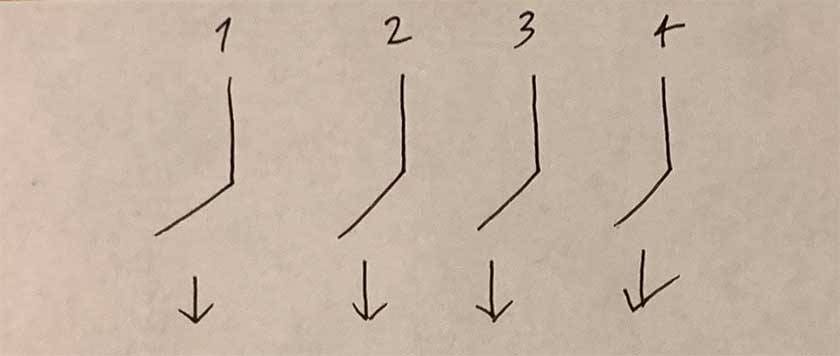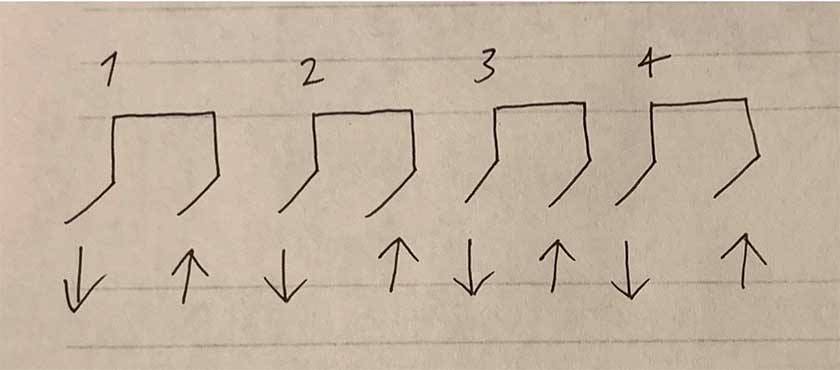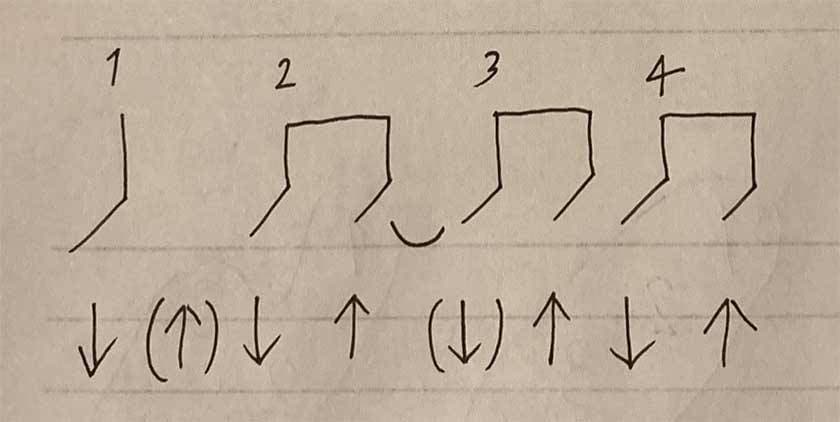Hello, this is Conservario.
Are you a beginner struggling with this problem?
“I’ve learned some chords and strumming patterns, but somehow, I always end up playing the same way...”
There can be many reasons for this, but naturally, you can’t do what you don’t know or haven’t practiced.
In this article, I’ll introduce solutions and practice methods to improve your strumming skills!
■ Solutions and Practice Methods
Let’s start with the most basic strumming pattern.
Simply strum down four times.
For chords, I recommend C or Am, as they can be played with just one finger.
You can use either your thumb or index finger.
It should sound like “Jaaan, jaaan, jaaan, jaaan.”
You might think, “This is too easy!”—but are you playing all four strums at exactly the same volume?
Most players assume they are, but if you listen carefully, you’ll likely notice:
Some strums are louder or softer than others. Sometimes all four strings are hit, but other times only three sound.
While you’ll eventually learn various strumming techniques, you must first master the basics. At this stage, pay close attention to every detail.
This careful practice will significantly affect your future progress.

Next, let’s double the speed of the previous strumming pattern.
Earlier, I played four slow downstrokes: “Jaaan, jaaan, jaaan, jaaan.”
Now, we double that to eight faster strums: “Jaja jaja jaja jaja.” (Writing it out like this may be a bit unclear—sorry about that!)
Playing only downstrokes at this speed would be too demanding, so let’s incorporate upstrokes as well.
Strum down-up, down-up, down-up, down-up—which makes a total of eight strums.
Since upstrokes can be tricky with the thumb, I recommend using your index finger.
When alternating between downstrokes and upstrokes, the volume tends to become uneven.
Be careful that your downstrokes don’t become louder than your upstrokes. If you focus too much on strumming, it can lead to sloppy left-hand form.
Make sure that all four strings are ringing clearly when you play the chords. If your ukulele starts slipping down, it will make it hard for both your right and left hands to move freely.
Support the instrument properly with your right hand, or place it on your leg for stability. Using a strap can also help.
Pay attention to your right hand, left hand, form, and sound—all of these elements are crucial.
Once you’ve practiced enough, you can move on to the final exercise.

Lastly, let’’s practice a pattern where ties appear. Just to clarify, when I say “tie,” I’m not referring to a country! In simple terms, a tie means sustaining a note.
This is a common term, so it’s a good opportunity to familiarize yourself with it. Please take a look at the image first before proceeding with the practice.

When written out, it’s like “Jan jajaan jajaja.” This involves alternating down and up strokes, and for the first time, you’ll use a technique called ‘dead strokes’.
The symbols (↑) and (↓) in parentheses indicate the dead strokes. If you’re not familiar with this technique, it might feel quite challenging, so please practice it very slowly. Make sure to follow the down, up, and dead strokes exactly as shown.
Just because it’s difficult, don’t change the technique to something easier or more convenient—this would make your practice ineffective. A common mistake when first practicing this pattern is changing the speed of the dead stroke. While you might be used to down and up strokes, the dead stroke will still be new to you. If you’re not accustomed to the dead stroke, your playing might get sloppy, such as the motion stopping or your hand suddenly speeding up.
Focus on your right hand and stop looking at your left-hand chords for a moment. Carefully observe whether the downstroke, upstroke, and dead stroke are being executed smoothly.
Once you’re more comfortable with the strokes, practice them while properly pressing the chords with your left hand.
■ Conclusion
I have introduced three strumming patterns, along with their practice methods and important points to keep in mind. Strumming is truly a deep and intricate technique.
Many professionals even say that strumming is more difficult than left-hand techniques on the ukulele. Frankly, if you can’t play these three patterns perfectly, practicing fancy strumming patterns is pointless.
Being in a “I can play it” state, rather than an “I actually can’t play it” state, is even more problematic. I completely understand the desire to learn difficult strumming techniques.
That’s important, so don’t forget this drive. However, it’s more important to be able to play the simple ones perfectly and coolly.
Please don’t belittle basic strumming patterns—practice them regularly.
Once you’ve practiced enough and can play them well, try incorporating chord changes while continuing to practice strumming. If you can play them beautifully and steadily without disturbing the rhythm during any chord changes, you’ll have made significant progress.
For those who want to master strumming further, I am currently working on an advanced-level strumming column. Please look forward to it. Thank you for reading until the end.
The “sound & person” column is made up of contributions from you.
For details about contributing, click here.











![[Enjoy the Ukulele Even More!] Do I Have to Practice the Basics?](/contents/uploads/thumbs/5/2022/2/20220221_5_16789_1.jpg)
![[Enjoy the Ukulele Even More!] Playing, Extending, and Stopping the Sound](/contents/uploads/thumbs/5/2022/2/20220218_5_16781_1.jpg)
![[Enjoy the Ukulele Even More!] Ukulele Condition Check You Should Do](/contents/uploads/thumbs/5/2022/2/20220214_5_16699_1.jpg)
![[Enjoy the Ukulele Even More!] Basic Knowledge Before You Start Playing](/contents/uploads/thumbs/5/2022/2/20220214_5_16700_1.jpg)

![[Enjoy the Ukulele Even More!] Practice that You Can Do Even Without Your Ukulele](/contents/uploads/thumbs/5/2022/1/20220131_5_16448_1.jpg)
 ウクレレのチューニング方法
ウクレレのチューニング方法
 ウクレレの各部名称
ウクレレの各部名称
 ウクレレの種類
ウクレレの種類
 ウクレレスタートガイド
ウクレレスタートガイド
 めちゃラク!ギター講座
めちゃラク!ギター講座
 ウクレレ初心者講座
ウクレレ初心者講座















